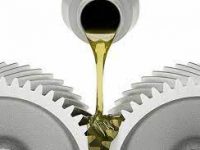According to Suelen Rodrigues, TestOil Data Analyst, MLA I, the three most common gear lubricant formulations are those with rust and oxidation inhibitors (R&O), extreme pressure (EP) additives and those that are compounded gear lubricants. Each has the objective of optimizing gear lubrication.
- R&O: These additives prevent or reduce internal rust and corrosion by neutralizing acids and forming a chemical protective barrier to repel moisture from metal surfaces. Machine conditions that generally require these products include high speeds, low loads, and uniform loading (no shock loading).
- Extreme Pressure: These additives react chemically with metal surfaces to form a sacrificial surface film that prevents the welding and seizure of opposing asperities caused by metal-to-metal contact (adhesive wear). They are activated at high loads and by the high contact temperatures that are created. These additives usually contain sulfur and phosphorus compounds (and occasionally boron compounds).
- Compounded Lubricants: The compounded gear oil is a mineral basestock mixed with synthetic fatty acid which gives these lubricants excellent lubricity and film strength. The most common application for these lubricants is worm gears. Compounded gear oils are used where yellow metals, such as copper alloy, are present.
Suelen explains why additives need to be monitored so closely. “Additive depletion is often used to estimate the remaining useful life of the oil. For many additives, the longer the oil remains in service, the less effective the remaining additive package is in protecting the equipment. When the additive package weakens, viscosity increases, sludge begins to form, corrosive acids start to attack metal surfaces, and/or wear begins to increase.”
Performing oil analysis on a regular basis establishes a baseline for the lubricant and machine condition and can identify potential problems before a major repair is necessary. It is important to monitor the additive package, any degradation of the lubricant that may be occurring, and the presence of contaminants. To that end, Suelen and TestOil recommend the following tests:
- Viscosity: This measures the oil’s resistance to flow (shear stress) under certain conditions and is the most important property to monitor.
- Elemental Spectroscopy: This test uses a spectrometer to measure the levels of specific chemical elements present in an oil (wear metals, additives, and contaminants).
- Acid Number: This measures the level of acidity in a lubricant.High acid levels can indicate excessive oil oxidation or depletion of the oil additives and can lead to corrosion of the internal components.
- FTIR Spectroscopy: This test produces direct information on the molecular species of interest, including additives, fluid breakdown products, and external contamination. It compares infrared spectra of used oil to a baseline spectrum.
- Ferrous Wear Concentration: This yields a direct measure of the amount of ferrous wear metals present in a sample. Trending of ferrous concentration reveals changes in the wear mode of the system.
“We perform the analytical ferrography test on all machine condition anomalies triggered by the basic testing,” Suelen adds, “It is the best method for determining severity and type of wear in the equipment. Analytical ferrography testing isolates wear debris and solid particulates for examination under a microscope. It can identify wear particles, their composition, and their origin by visually analyzing them microscopically.”
For more information on working with TestOil for oil analysis and training visit www.testoil.com. Contact: 216-251-2510; sales@testoil.com.
About TestOil
With more than 30 years of experience in the oil analysis industry, TestOil focuses exclusively on assisting industrial facilities with reducing maintenance costs and avoiding unexpected downtime through oil analysis program implementation. As industry experts in diagnosing oil-related issues in equipment such as turbines, hydraulics, gearboxes, pumps, compressors and diesel generators, TestOil provides customers with a guarantee of same-day turnaround on all routine testing. With in-house, certified training professionals, TestOil offers lubrication and oil analysis training, private onsite training, certification training and exams, and educational webinars. For more information on partnering with TestOil on oil analysis programs or training opportunities visit www.testoil.com.
Some of the material for this post came from an excellent Noria article


